BUS 832 Assessment 1: Comparative Review of Diversity Articles
VerifiedAdded on 2022/11/30
|8
|1847
|253
Report
AI Summary
This report presents a comparative review of two articles centered on gender diversity within corporate boards and management practices. The first article, "The Paradox of Diversity Initiatives: When Organizational Needs Differ from Employee Preferences," explores the challenges of fostering gender diversity in the modern corporate world, examining the effectiveness of different diversity initiatives and the impact of counterfactuals on employee perceptions. The second article, "Toward Gender Diversity on Corporate Boards: Evaluating Government Quotas (EU) Versus Shareholder Resolutions (US) from the Perspective of Third Wave Feminism," investigates the evolution of gender equality issues, focusing on the underrepresentation of women in senior management positions and evaluating the relative success of government quotas versus shareholder resolutions in promoting gender diversity. The report analyzes the strengths and weaknesses of each article, considering factors like theoretical approaches, research methodologies, and real-world implications, while also reflecting on the author's personal experiences with diversity in the workplace. The conclusion emphasizes the importance of diversity management for achieving brand image, employee loyalty, and retention.
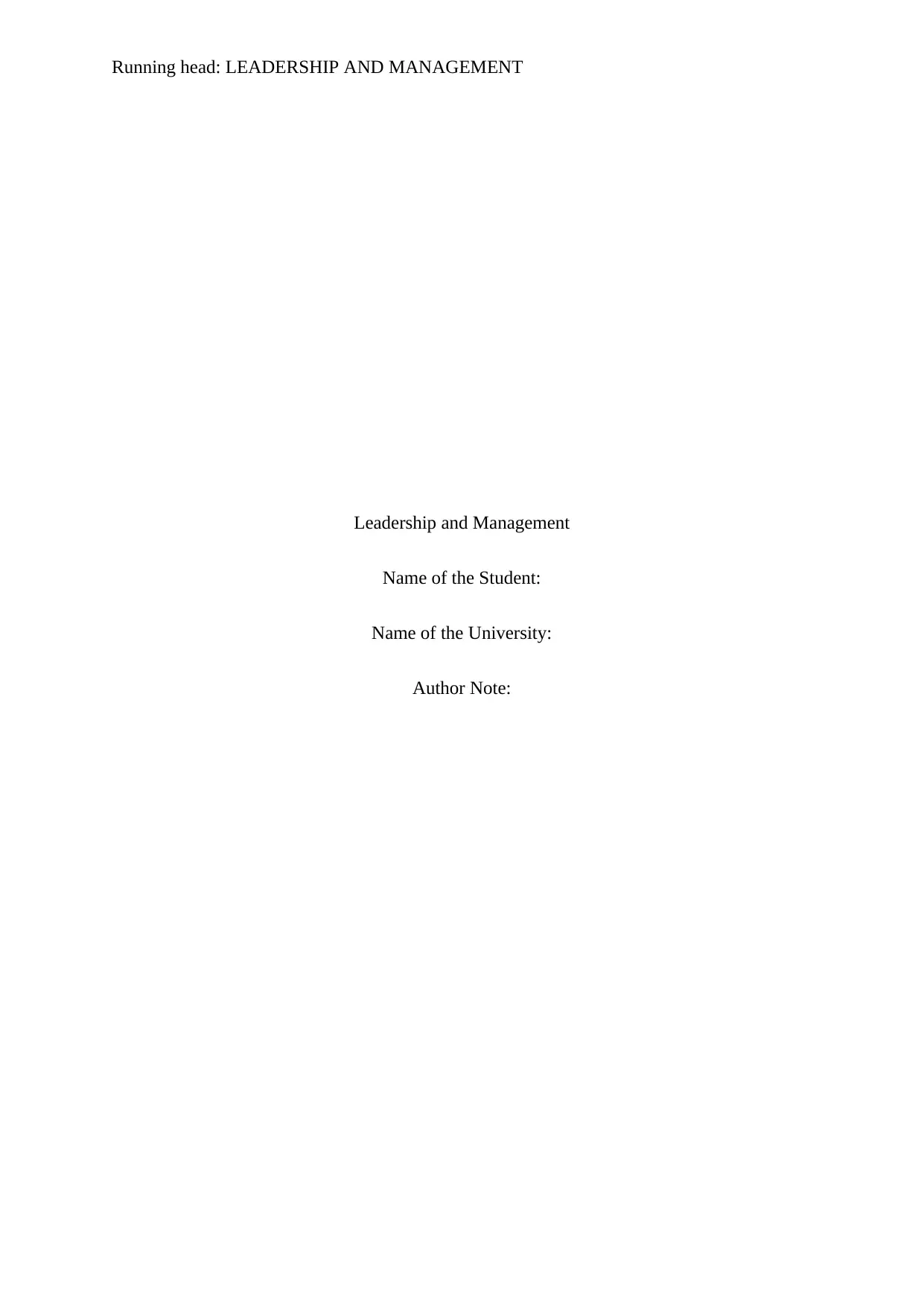
Running head: LEADERSHIP AND MANAGEMENT
Leadership and Management
Name of the Student:
Name of the University:
Author Note:
Leadership and Management
Name of the Student:
Name of the University:
Author Note:
Paraphrase This Document
Need a fresh take? Get an instant paraphrase of this document with our AI Paraphraser
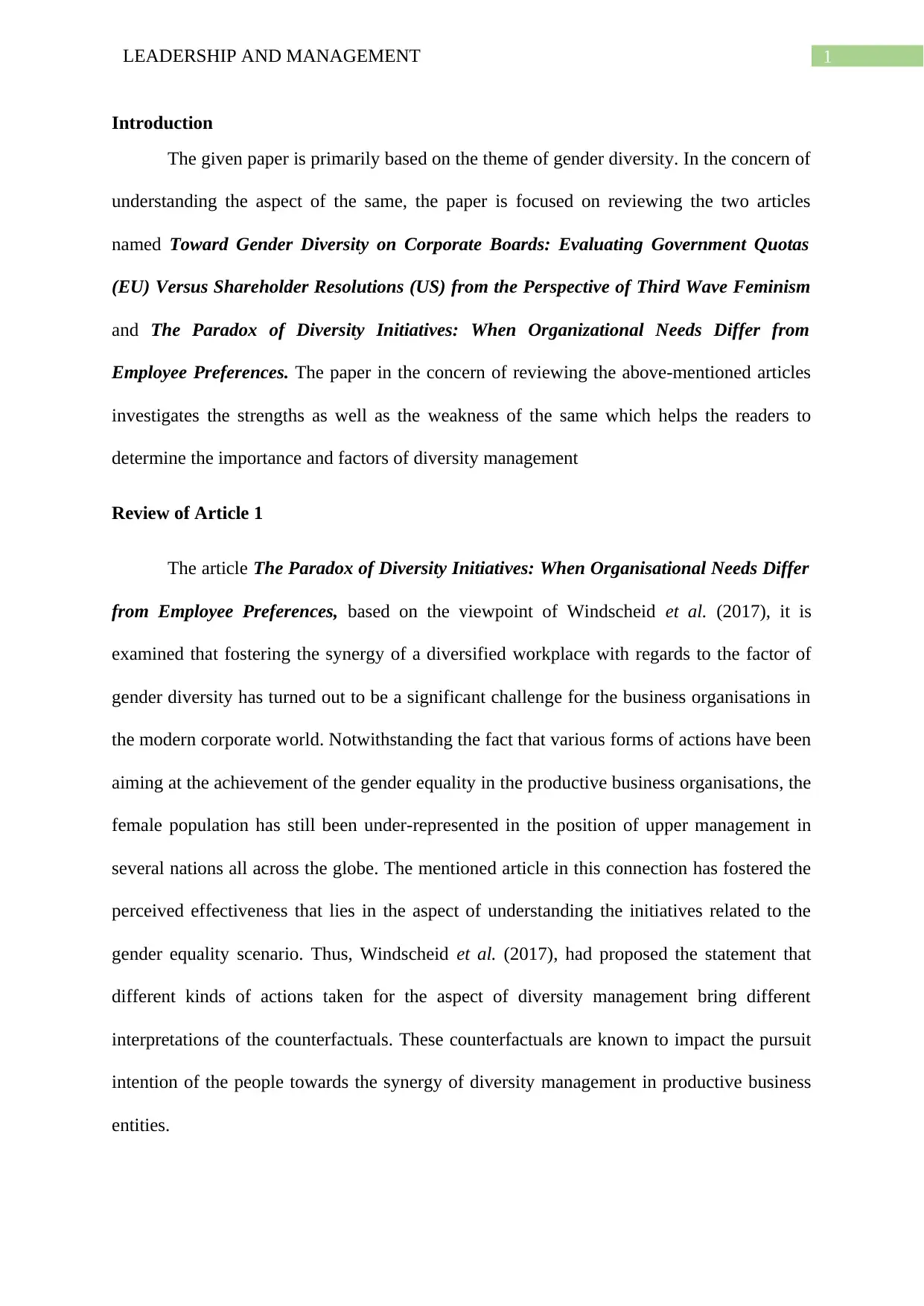
1LEADERSHIP AND MANAGEMENT
Introduction
The given paper is primarily based on the theme of gender diversity. In the concern of
understanding the aspect of the same, the paper is focused on reviewing the two articles
named Toward Gender Diversity on Corporate Boards: Evaluating Government Quotas
(EU) Versus Shareholder Resolutions (US) from the Perspective of Third Wave Feminism
and The Paradox of Diversity Initiatives: When Organizational Needs Differ from
Employee Preferences. The paper in the concern of reviewing the above-mentioned articles
investigates the strengths as well as the weakness of the same which helps the readers to
determine the importance and factors of diversity management
Review of Article 1
The article The Paradox of Diversity Initiatives: When Organisational Needs Differ
from Employee Preferences, based on the viewpoint of Windscheid et al. (2017), it is
examined that fostering the synergy of a diversified workplace with regards to the factor of
gender diversity has turned out to be a significant challenge for the business organisations in
the modern corporate world. Notwithstanding the fact that various forms of actions have been
aiming at the achievement of the gender equality in the productive business organisations, the
female population has still been under-represented in the position of upper management in
several nations all across the globe. The mentioned article in this connection has fostered the
perceived effectiveness that lies in the aspect of understanding the initiatives related to the
gender equality scenario. Thus, Windscheid et al. (2017), had proposed the statement that
different kinds of actions taken for the aspect of diversity management bring different
interpretations of the counterfactuals. These counterfactuals are known to impact the pursuit
intention of the people towards the synergy of diversity management in productive business
entities.
Introduction
The given paper is primarily based on the theme of gender diversity. In the concern of
understanding the aspect of the same, the paper is focused on reviewing the two articles
named Toward Gender Diversity on Corporate Boards: Evaluating Government Quotas
(EU) Versus Shareholder Resolutions (US) from the Perspective of Third Wave Feminism
and The Paradox of Diversity Initiatives: When Organizational Needs Differ from
Employee Preferences. The paper in the concern of reviewing the above-mentioned articles
investigates the strengths as well as the weakness of the same which helps the readers to
determine the importance and factors of diversity management
Review of Article 1
The article The Paradox of Diversity Initiatives: When Organisational Needs Differ
from Employee Preferences, based on the viewpoint of Windscheid et al. (2017), it is
examined that fostering the synergy of a diversified workplace with regards to the factor of
gender diversity has turned out to be a significant challenge for the business organisations in
the modern corporate world. Notwithstanding the fact that various forms of actions have been
aiming at the achievement of the gender equality in the productive business organisations, the
female population has still been under-represented in the position of upper management in
several nations all across the globe. The mentioned article in this connection has fostered the
perceived effectiveness that lies in the aspect of understanding the initiatives related to the
gender equality scenario. Thus, Windscheid et al. (2017), had proposed the statement that
different kinds of actions taken for the aspect of diversity management bring different
interpretations of the counterfactuals. These counterfactuals are known to impact the pursuit
intention of the people towards the synergy of diversity management in productive business
entities.
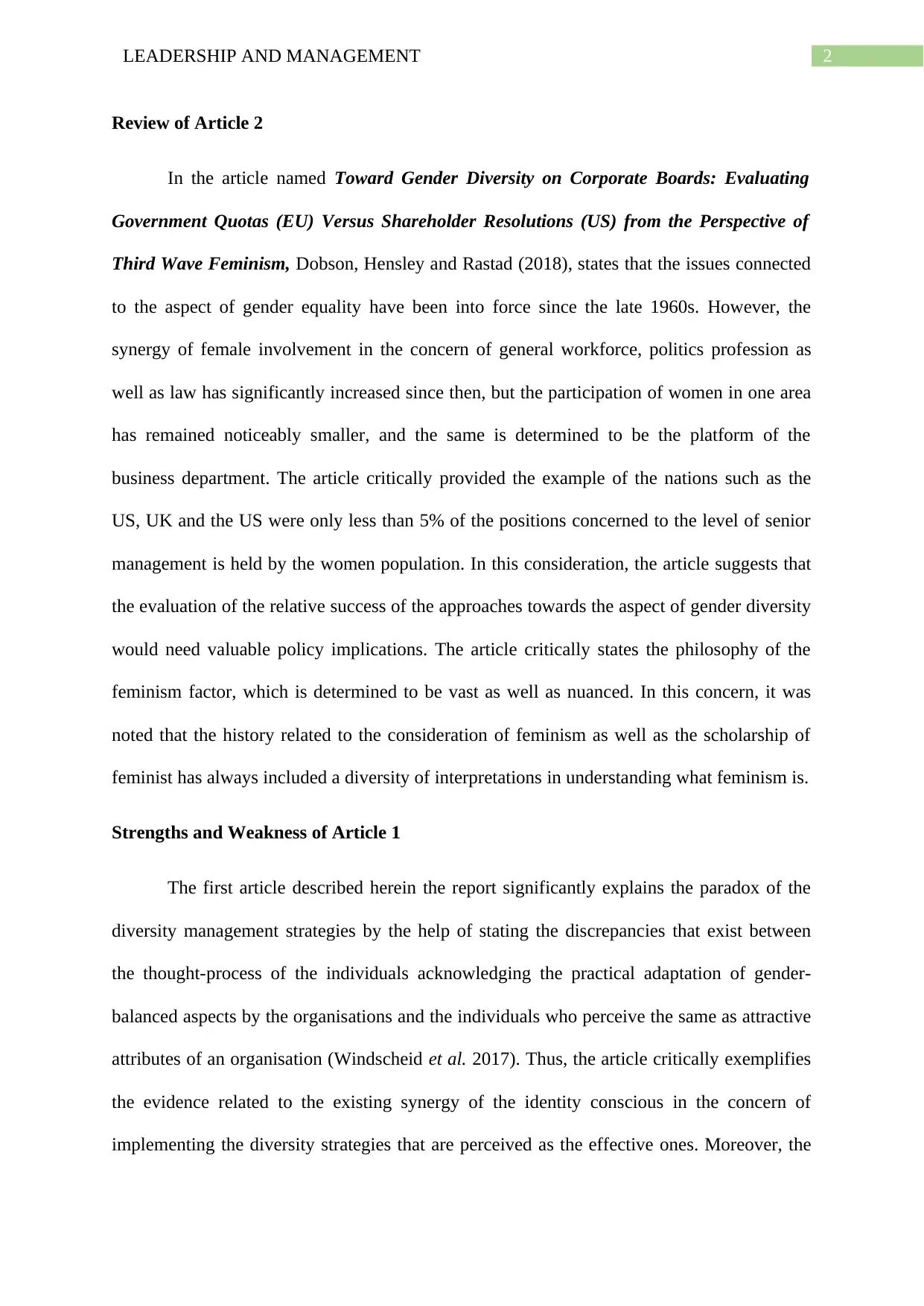
2LEADERSHIP AND MANAGEMENT
Review of Article 2
In the article named Toward Gender Diversity on Corporate Boards: Evaluating
Government Quotas (EU) Versus Shareholder Resolutions (US) from the Perspective of
Third Wave Feminism, Dobson, Hensley and Rastad (2018), states that the issues connected
to the aspect of gender equality have been into force since the late 1960s. However, the
synergy of female involvement in the concern of general workforce, politics profession as
well as law has significantly increased since then, but the participation of women in one area
has remained noticeably smaller, and the same is determined to be the platform of the
business department. The article critically provided the example of the nations such as the
US, UK and the US were only less than 5% of the positions concerned to the level of senior
management is held by the women population. In this consideration, the article suggests that
the evaluation of the relative success of the approaches towards the aspect of gender diversity
would need valuable policy implications. The article critically states the philosophy of the
feminism factor, which is determined to be vast as well as nuanced. In this concern, it was
noted that the history related to the consideration of feminism as well as the scholarship of
feminist has always included a diversity of interpretations in understanding what feminism is.
Strengths and Weakness of Article 1
The first article described herein the report significantly explains the paradox of the
diversity management strategies by the help of stating the discrepancies that exist between
the thought-process of the individuals acknowledging the practical adaptation of gender-
balanced aspects by the organisations and the individuals who perceive the same as attractive
attributes of an organisation (Windscheid et al. 2017). Thus, the article critically exemplifies
the evidence related to the existing synergy of the identity conscious in the concern of
implementing the diversity strategies that are perceived as the effective ones. Moreover, the
Review of Article 2
In the article named Toward Gender Diversity on Corporate Boards: Evaluating
Government Quotas (EU) Versus Shareholder Resolutions (US) from the Perspective of
Third Wave Feminism, Dobson, Hensley and Rastad (2018), states that the issues connected
to the aspect of gender equality have been into force since the late 1960s. However, the
synergy of female involvement in the concern of general workforce, politics profession as
well as law has significantly increased since then, but the participation of women in one area
has remained noticeably smaller, and the same is determined to be the platform of the
business department. The article critically provided the example of the nations such as the
US, UK and the US were only less than 5% of the positions concerned to the level of senior
management is held by the women population. In this consideration, the article suggests that
the evaluation of the relative success of the approaches towards the aspect of gender diversity
would need valuable policy implications. The article critically states the philosophy of the
feminism factor, which is determined to be vast as well as nuanced. In this concern, it was
noted that the history related to the consideration of feminism as well as the scholarship of
feminist has always included a diversity of interpretations in understanding what feminism is.
Strengths and Weakness of Article 1
The first article described herein the report significantly explains the paradox of the
diversity management strategies by the help of stating the discrepancies that exist between
the thought-process of the individuals acknowledging the practical adaptation of gender-
balanced aspects by the organisations and the individuals who perceive the same as attractive
attributes of an organisation (Windscheid et al. 2017). Thus, the article critically exemplifies
the evidence related to the existing synergy of the identity conscious in the concern of
implementing the diversity strategies that are perceived as the effective ones. Moreover, the
⊘ This is a preview!⊘
Do you want full access?
Subscribe today to unlock all pages.

Trusted by 1+ million students worldwide
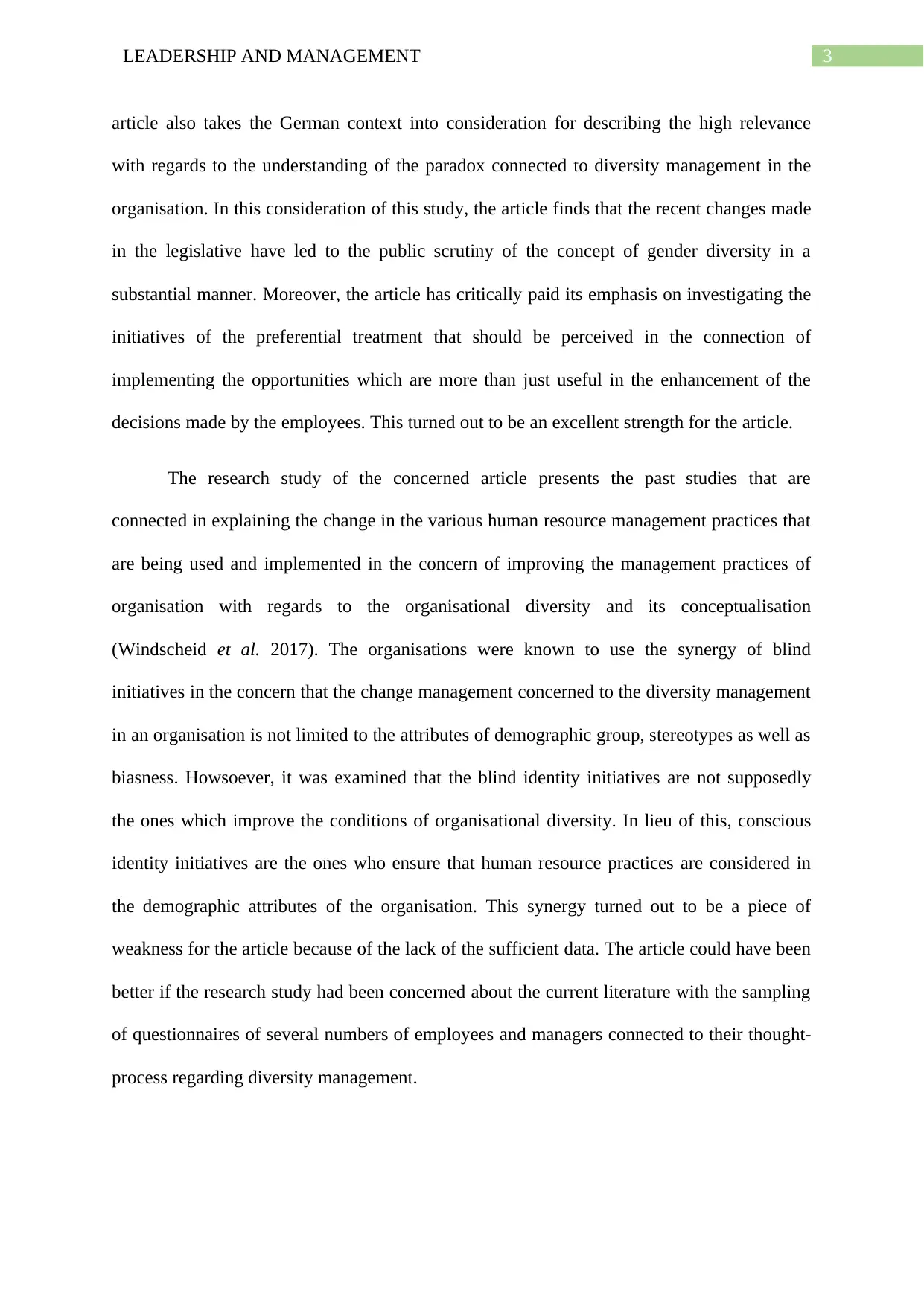
3LEADERSHIP AND MANAGEMENT
article also takes the German context into consideration for describing the high relevance
with regards to the understanding of the paradox connected to diversity management in the
organisation. In this consideration of this study, the article finds that the recent changes made
in the legislative have led to the public scrutiny of the concept of gender diversity in a
substantial manner. Moreover, the article has critically paid its emphasis on investigating the
initiatives of the preferential treatment that should be perceived in the connection of
implementing the opportunities which are more than just useful in the enhancement of the
decisions made by the employees. This turned out to be an excellent strength for the article.
The research study of the concerned article presents the past studies that are
connected in explaining the change in the various human resource management practices that
are being used and implemented in the concern of improving the management practices of
organisation with regards to the organisational diversity and its conceptualisation
(Windscheid et al. 2017). The organisations were known to use the synergy of blind
initiatives in the concern that the change management concerned to the diversity management
in an organisation is not limited to the attributes of demographic group, stereotypes as well as
biasness. Howsoever, it was examined that the blind identity initiatives are not supposedly
the ones which improve the conditions of organisational diversity. In lieu of this, conscious
identity initiatives are the ones who ensure that human resource practices are considered in
the demographic attributes of the organisation. This synergy turned out to be a piece of
weakness for the article because of the lack of the sufficient data. The article could have been
better if the research study had been concerned about the current literature with the sampling
of questionnaires of several numbers of employees and managers connected to their thought-
process regarding diversity management.
article also takes the German context into consideration for describing the high relevance
with regards to the understanding of the paradox connected to diversity management in the
organisation. In this consideration of this study, the article finds that the recent changes made
in the legislative have led to the public scrutiny of the concept of gender diversity in a
substantial manner. Moreover, the article has critically paid its emphasis on investigating the
initiatives of the preferential treatment that should be perceived in the connection of
implementing the opportunities which are more than just useful in the enhancement of the
decisions made by the employees. This turned out to be an excellent strength for the article.
The research study of the concerned article presents the past studies that are
connected in explaining the change in the various human resource management practices that
are being used and implemented in the concern of improving the management practices of
organisation with regards to the organisational diversity and its conceptualisation
(Windscheid et al. 2017). The organisations were known to use the synergy of blind
initiatives in the concern that the change management concerned to the diversity management
in an organisation is not limited to the attributes of demographic group, stereotypes as well as
biasness. Howsoever, it was examined that the blind identity initiatives are not supposedly
the ones which improve the conditions of organisational diversity. In lieu of this, conscious
identity initiatives are the ones who ensure that human resource practices are considered in
the demographic attributes of the organisation. This synergy turned out to be a piece of
weakness for the article because of the lack of the sufficient data. The article could have been
better if the research study had been concerned about the current literature with the sampling
of questionnaires of several numbers of employees and managers connected to their thought-
process regarding diversity management.
Paraphrase This Document
Need a fresh take? Get an instant paraphrase of this document with our AI Paraphraser
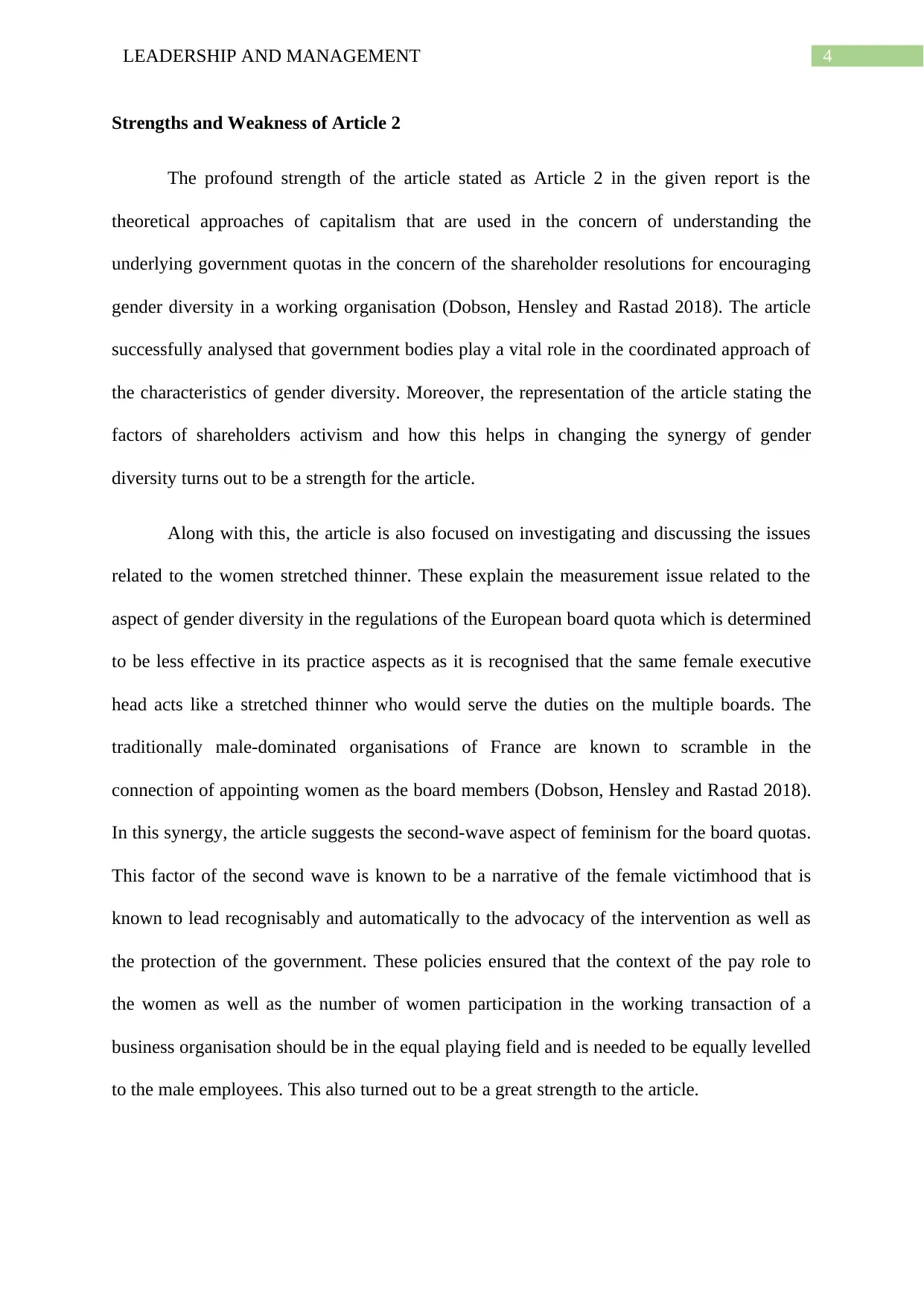
4LEADERSHIP AND MANAGEMENT
Strengths and Weakness of Article 2
The profound strength of the article stated as Article 2 in the given report is the
theoretical approaches of capitalism that are used in the concern of understanding the
underlying government quotas in the concern of the shareholder resolutions for encouraging
gender diversity in a working organisation (Dobson, Hensley and Rastad 2018). The article
successfully analysed that government bodies play a vital role in the coordinated approach of
the characteristics of gender diversity. Moreover, the representation of the article stating the
factors of shareholders activism and how this helps in changing the synergy of gender
diversity turns out to be a strength for the article.
Along with this, the article is also focused on investigating and discussing the issues
related to the women stretched thinner. These explain the measurement issue related to the
aspect of gender diversity in the regulations of the European board quota which is determined
to be less effective in its practice aspects as it is recognised that the same female executive
head acts like a stretched thinner who would serve the duties on the multiple boards. The
traditionally male-dominated organisations of France are known to scramble in the
connection of appointing women as the board members (Dobson, Hensley and Rastad 2018).
In this synergy, the article suggests the second-wave aspect of feminism for the board quotas.
This factor of the second wave is known to be a narrative of the female victimhood that is
known to lead recognisably and automatically to the advocacy of the intervention as well as
the protection of the government. These policies ensured that the context of the pay role to
the women as well as the number of women participation in the working transaction of a
business organisation should be in the equal playing field and is needed to be equally levelled
to the male employees. This also turned out to be a great strength to the article.
Strengths and Weakness of Article 2
The profound strength of the article stated as Article 2 in the given report is the
theoretical approaches of capitalism that are used in the concern of understanding the
underlying government quotas in the concern of the shareholder resolutions for encouraging
gender diversity in a working organisation (Dobson, Hensley and Rastad 2018). The article
successfully analysed that government bodies play a vital role in the coordinated approach of
the characteristics of gender diversity. Moreover, the representation of the article stating the
factors of shareholders activism and how this helps in changing the synergy of gender
diversity turns out to be a strength for the article.
Along with this, the article is also focused on investigating and discussing the issues
related to the women stretched thinner. These explain the measurement issue related to the
aspect of gender diversity in the regulations of the European board quota which is determined
to be less effective in its practice aspects as it is recognised that the same female executive
head acts like a stretched thinner who would serve the duties on the multiple boards. The
traditionally male-dominated organisations of France are known to scramble in the
connection of appointing women as the board members (Dobson, Hensley and Rastad 2018).
In this synergy, the article suggests the second-wave aspect of feminism for the board quotas.
This factor of the second wave is known to be a narrative of the female victimhood that is
known to lead recognisably and automatically to the advocacy of the intervention as well as
the protection of the government. These policies ensured that the context of the pay role to
the women as well as the number of women participation in the working transaction of a
business organisation should be in the equal playing field and is needed to be equally levelled
to the male employees. This also turned out to be a great strength to the article.
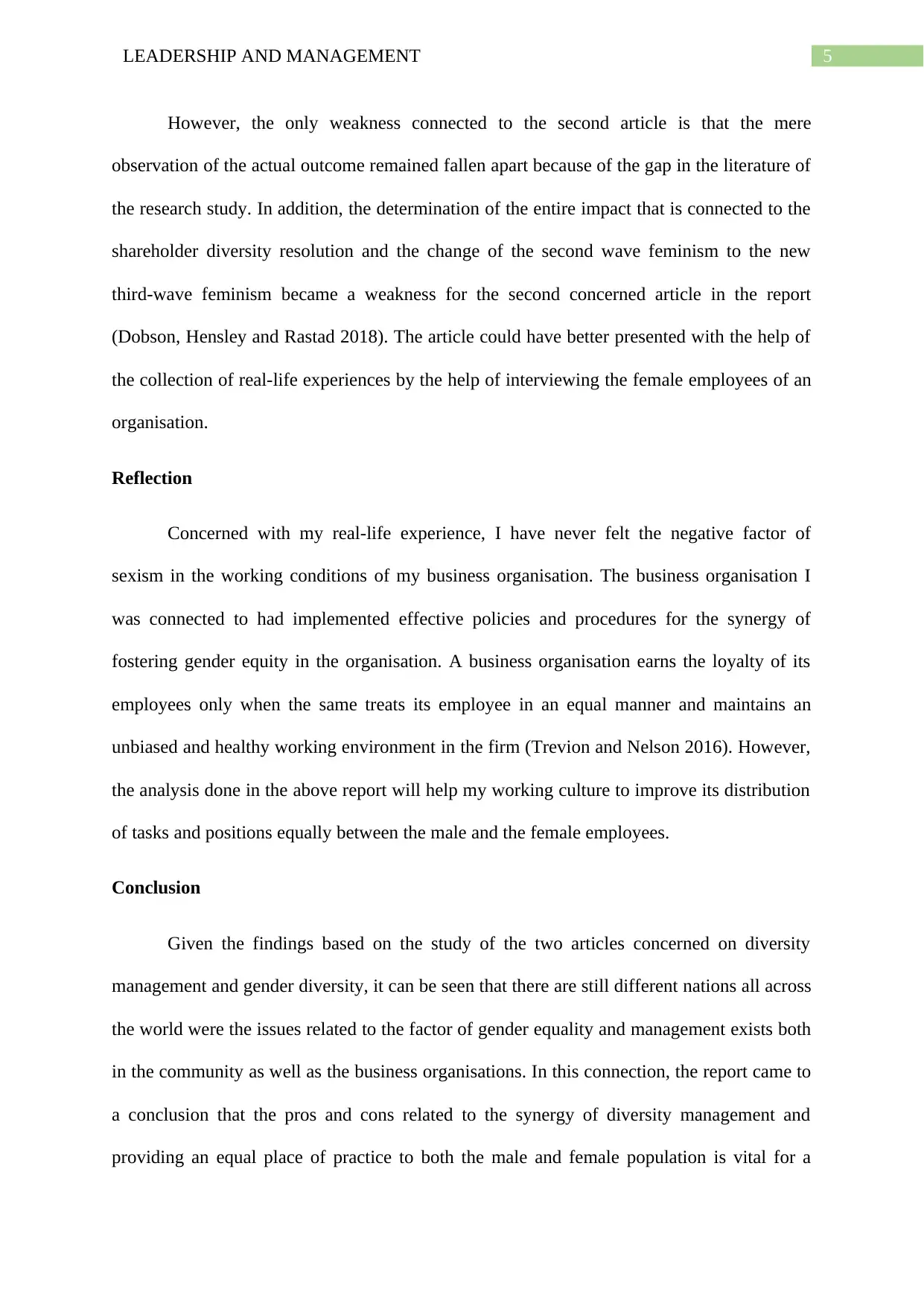
5LEADERSHIP AND MANAGEMENT
However, the only weakness connected to the second article is that the mere
observation of the actual outcome remained fallen apart because of the gap in the literature of
the research study. In addition, the determination of the entire impact that is connected to the
shareholder diversity resolution and the change of the second wave feminism to the new
third-wave feminism became a weakness for the second concerned article in the report
(Dobson, Hensley and Rastad 2018). The article could have better presented with the help of
the collection of real-life experiences by the help of interviewing the female employees of an
organisation.
Reflection
Concerned with my real-life experience, I have never felt the negative factor of
sexism in the working conditions of my business organisation. The business organisation I
was connected to had implemented effective policies and procedures for the synergy of
fostering gender equity in the organisation. A business organisation earns the loyalty of its
employees only when the same treats its employee in an equal manner and maintains an
unbiased and healthy working environment in the firm (Trevion and Nelson 2016). However,
the analysis done in the above report will help my working culture to improve its distribution
of tasks and positions equally between the male and the female employees.
Conclusion
Given the findings based on the study of the two articles concerned on diversity
management and gender diversity, it can be seen that there are still different nations all across
the world were the issues related to the factor of gender equality and management exists both
in the community as well as the business organisations. In this connection, the report came to
a conclusion that the pros and cons related to the synergy of diversity management and
providing an equal place of practice to both the male and female population is vital for a
However, the only weakness connected to the second article is that the mere
observation of the actual outcome remained fallen apart because of the gap in the literature of
the research study. In addition, the determination of the entire impact that is connected to the
shareholder diversity resolution and the change of the second wave feminism to the new
third-wave feminism became a weakness for the second concerned article in the report
(Dobson, Hensley and Rastad 2018). The article could have better presented with the help of
the collection of real-life experiences by the help of interviewing the female employees of an
organisation.
Reflection
Concerned with my real-life experience, I have never felt the negative factor of
sexism in the working conditions of my business organisation. The business organisation I
was connected to had implemented effective policies and procedures for the synergy of
fostering gender equity in the organisation. A business organisation earns the loyalty of its
employees only when the same treats its employee in an equal manner and maintains an
unbiased and healthy working environment in the firm (Trevion and Nelson 2016). However,
the analysis done in the above report will help my working culture to improve its distribution
of tasks and positions equally between the male and the female employees.
Conclusion
Given the findings based on the study of the two articles concerned on diversity
management and gender diversity, it can be seen that there are still different nations all across
the world were the issues related to the factor of gender equality and management exists both
in the community as well as the business organisations. In this connection, the report came to
a conclusion that the pros and cons related to the synergy of diversity management and
providing an equal place of practice to both the male and female population is vital for a
⊘ This is a preview!⊘
Do you want full access?
Subscribe today to unlock all pages.

Trusted by 1+ million students worldwide
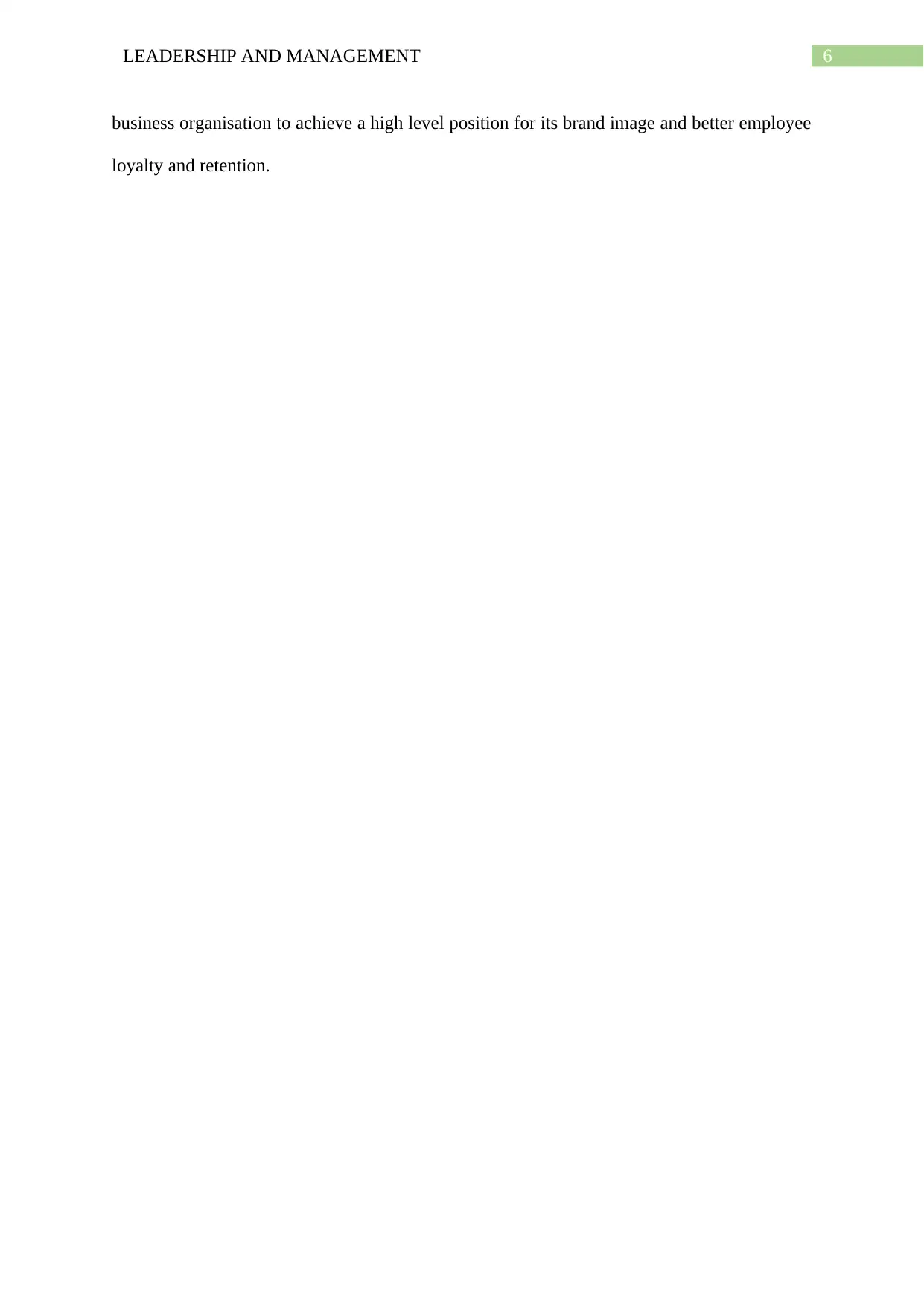
6LEADERSHIP AND MANAGEMENT
business organisation to achieve a high level position for its brand image and better employee
loyalty and retention.
business organisation to achieve a high level position for its brand image and better employee
loyalty and retention.
Paraphrase This Document
Need a fresh take? Get an instant paraphrase of this document with our AI Paraphraser
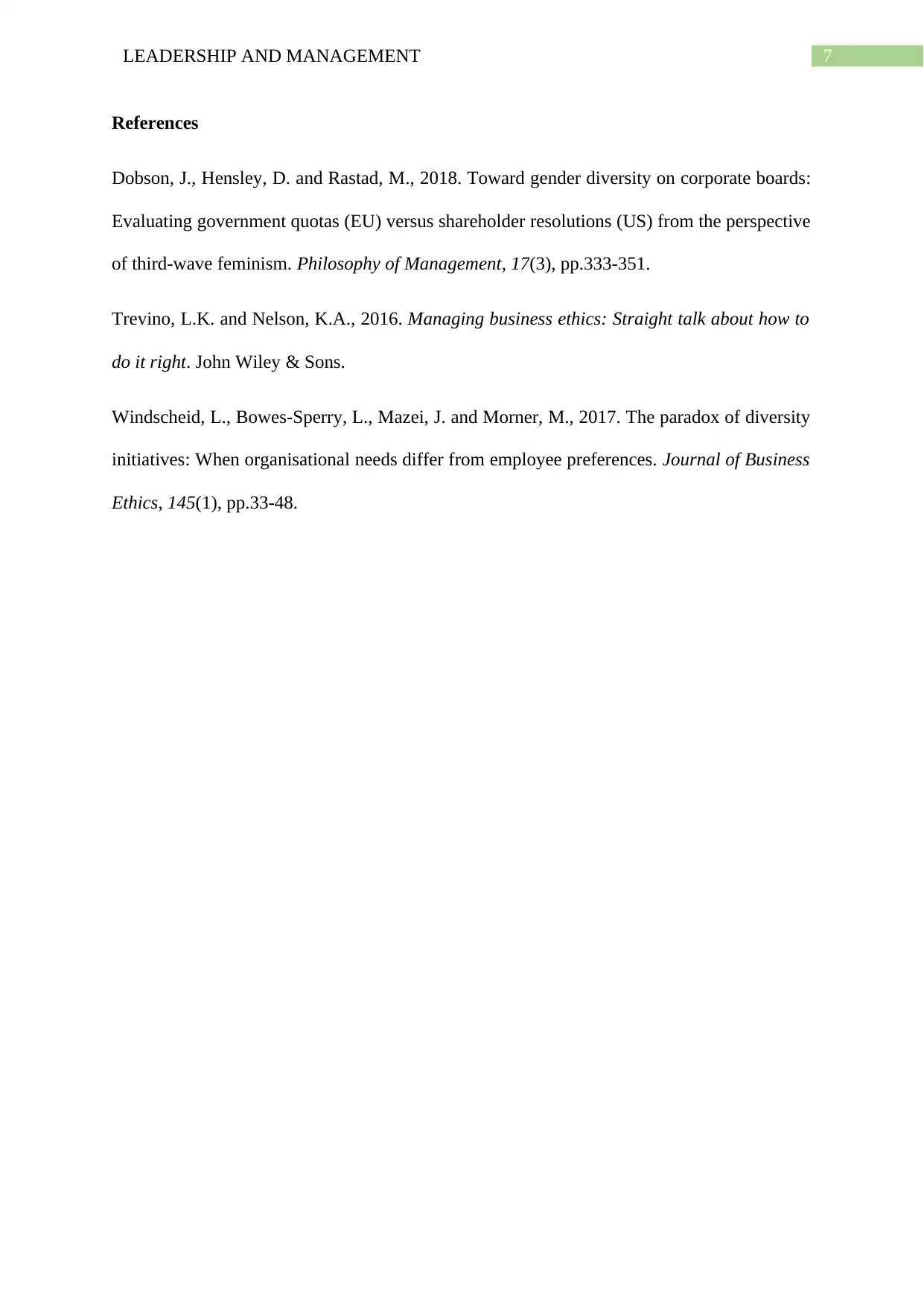
7LEADERSHIP AND MANAGEMENT
References
Dobson, J., Hensley, D. and Rastad, M., 2018. Toward gender diversity on corporate boards:
Evaluating government quotas (EU) versus shareholder resolutions (US) from the perspective
of third-wave feminism. Philosophy of Management, 17(3), pp.333-351.
Trevino, L.K. and Nelson, K.A., 2016. Managing business ethics: Straight talk about how to
do it right. John Wiley & Sons.
Windscheid, L., Bowes-Sperry, L., Mazei, J. and Morner, M., 2017. The paradox of diversity
initiatives: When organisational needs differ from employee preferences. Journal of Business
Ethics, 145(1), pp.33-48.
References
Dobson, J., Hensley, D. and Rastad, M., 2018. Toward gender diversity on corporate boards:
Evaluating government quotas (EU) versus shareholder resolutions (US) from the perspective
of third-wave feminism. Philosophy of Management, 17(3), pp.333-351.
Trevino, L.K. and Nelson, K.A., 2016. Managing business ethics: Straight talk about how to
do it right. John Wiley & Sons.
Windscheid, L., Bowes-Sperry, L., Mazei, J. and Morner, M., 2017. The paradox of diversity
initiatives: When organisational needs differ from employee preferences. Journal of Business
Ethics, 145(1), pp.33-48.
1 out of 8
Related Documents
Your All-in-One AI-Powered Toolkit for Academic Success.
+13062052269
info@desklib.com
Available 24*7 on WhatsApp / Email
![[object Object]](/_next/static/media/star-bottom.7253800d.svg)
Unlock your academic potential
Copyright © 2020–2025 A2Z Services. All Rights Reserved. Developed and managed by ZUCOL.





